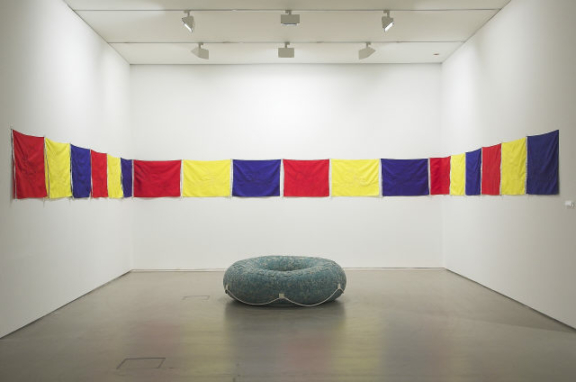
João Pedro Vale
Are you safe when you are dreaming
Lisbon, 1976
Amidst the diversity of aesthetic and thematic proposals from this generation whose outlook began to be shaped in the late twentieth-century, João Pedro Vale sets himself apart in the production of sculpture and installation, by tackling – in very broad terms – themes such as desire, identity, the body or interpersonal relations.
One of his first works, Untitled, 1999, shows the audience a video of the artist’s torso on which he has drawn four points and written the following commands: “1- Set the paper; 2 – Connect the dots; 3 – Paint; 4 – Sell”. The visitor should then use the white paper sheets made available alongside the projection and comply with the proposed exercise. Although this is an initial work, largely distant from the greater part of the artist’s production, such an exercise of reflection on artistic value, as well as the appeal to public intervention, both reflect the importance that the artistic heritage of previous decades held for the young creator. On the other hand, João Pedro Vale would once again use his naked torso as a medium in 2009 in the photograph Amália.
However the works that definitively affirmed the originality of his production were Can I wash you? and Please Don’t go!, also from 1999. The former, a sculpture of 120 cm in diameter and 10 cm high, placed on the floor, is composed of 90 bars of blue and white soap on which the phrase in the work’s title is inscribed. Likewise, Please Don’t Go! is a phrase taken out of a pop music refrain, which is inscribed on a rug of strawberry-flavoured and trampled chewing gum. In both cases, one can highlight characteristics that will mark the artist’s oeuvre in the following years: the decontextualization of materials and everyday objects, altering their functions and hence suggesting the attribution of a perverted symbolism that will guide the spectators gaze over João Pedro Vale’s imaginary; the easy identification of materials, mainly through the strong aromas that define a sensorial experience of the work (a subsequent example would be Spice Sculptures, 2009); addressing the visitor by means of interjections posed by the works, always highlighting human relations, contact, dependence, desire, in a range of tones that go from the humorous to the menacing (Help!, 2000 or Are you safe when you dreaming?, 2000, a work in which the artist used soap again as material, only this time shaped as a buoy).
Whether in installations, performances, sculpture or, more recently, graphic works and interventions in public space, João Pedro Vale has been establishing a dialogue with the objects of mass culture about functions and modes of use which had not been questioned before his approaches. The discourse aimed at the visitor, and a subtly direct critique, recently also aimed at questions of nationalism and of the History of Portugal (Nascido a 5 de Outubro, 2007), permanently call for our reaction. In many cases, this reaction is nothing but the strangeness that one feels in trying to decode the proposals of João Pedro Vale, always rooted in the pursuit of intimacy, in the revision of identity and in the experience that we make of the “other”.
MM
January 2012